Annual Report 2014
Financial Stability
A primary objective of the Federal Reserve since its inception has been the promotion of financial stability (box 1). As the U.S. and global financial systems have evolved, the Federal Reserve's role in helping maintain financial system stability has necessarily adapted.
The Dodd-Frank Wall Street Reform and Consumer Protection Act of 2010 (Dodd-Frank Act), for example, explicitly assigned the Federal Reserve new responsibilities for promoting financial stability. A central element in the Dodd-Frank Act is the requirement that the Federal Reserve and other financial regulatory agencies adopt a macroprudential approach to supervision and regulation. Whereas a traditional--or microprudential--approach to supervision and regulation focuses on the safety and soundness of individual institutions, the macroprudential approach centers on the stability of the financial system as a whole.
In particular, the macroprudential approach informs the supervision of systemically important financial institutions--including large bank holding companies (BHCs), the U.S. operations of certain foreign banking organizations (FBOs), and financial market utilities (FMUs). In addition, the Federal Reserve serves as a "consolidated supervisor" of nonbank financial companies that have been designated by the Financial Stability Oversight Council (FSOC) as institutions whose distress or failure could pose a threat to the stability of the U.S. financial system as a whole (see "Financial Stability Oversight Council Activities" later in this section).
Furthermore, the changing nature of risks and fluctuations in financial markets and the broader economy require timely monitoring of conditions in domestic and foreign financial markets, among financial institutions, and in the nonfinancial sector in order to identify the buildup of vulnerabilities that might require further study or policy action.
Promotion of financial stability strongly complements the primary goals of monetary policy--price stability and full employment. A smoothly operating financial system promotes the efficient allocation of saving and investment, facilitating economic growth and employment. And price stability contributes not only to the efficient allocation of resources in the real economy, but also to reduced uncertainty and efficient pricing in financial markets, thereby supporting financial stability.
This section discusses key financial stability activities undertaken by the Federal Reserve in 2014, which include monitoring risks to financial stability; macroprudential supervision and regulation of large, complex financial institutions; and domestic and international cooperation and coordination.
Some of these activities are also discussed elsewhere in this annual report. A broader set of economic and financial developments are discussed in section 2, "Monetary Policy and Economic Developments," with the discussion that follows concerning surveillance of economic and financial developments focused on financial stability. The full range of activities associated with supervision of systemically important financial institutions, designated nonbank companies, and designated FMUs is discussed in section 4, "Supervision and Regulation."
Box 1. Financial Stability and the Founding of the Federal Reserve
In 2014, the Federal Reserve marked the centennial anniversary of its activities since the passage of the Federal Reserve Act in 1913. Financial stability considerations were a key element in the founding of the System. Indeed, the Federal Reserve was created in response to the Panic of 1907, the latest in a series of severe financial panics that befell the nation in the late 19th and early 20th centuries.
This panic led to the creation of the National Monetary Commission, whose 1911 report was a major impetus to the Federal Reserve Act, signed into law by President Woodrow Wilson on December 23, 1913. Upon enactment, the process of organizing and opening the Board and the Reserve Banks across the country began. On November 16, 1914, the Federal Reserve System began full-fledged operations.
In the words of one author of the Federal Reserve Act, U.S. Senator Robert Latham Owen of Oklahoma, "It should always be kept in mind that...it is the prevention of panic, the protection of our commerce, the stability of business conditions, and the maintenance in active operation of the productive energies of the nation which is the question of vital importance."1 The Federal Reserve has continued to serve this function and adapt to U.S. and global economic and financial system evolution, innovation, conditions, and dynamics.
1. See Robert L. Owen (1919), The Federal Reserve Act: Its Origin and Principles (New York: Century Company), pp. 43-44. Return to text
Return to textMonitoring Risks to Financial Stability
In this Section:
Financial institutions are linked together through a complex set of relationships. Moreover, the condition of financial institutions and financial stability depends on the economic condition of the nonfinancial sector, whose borrowing from the financial sector implies that the strength of financial institutions' balance sheets depends on the condition of the nonfinancial sector. As a result, research on financial stability has been an important part of Federal Reserve efforts in pursuit of overall economic stability (see box 2 for information on recent research).
In order to understand the interaction among these factors and consider appropriate policy responses, the Federal Reserve maintains a flexible, forward-looking financial stability monitoring program to help inform policymakers of the financial system's vulnerabilities to a range of potential adverse events or shocks. Such a monitoring program is a critical part of a broader program in the Federal Reserve System to assess and address vulnerabilities in the U.S. financial system.
Each quarter, Federal Reserve Board staff systematically assess a standard set of vulnerabilities relevant for financial stability: asset valuations and risk appetite, leverage in the financial system, liquidity risks and maturity transformation by the financial system, and borrowing by the nonfinancial sector (households and nonfinancial businesses). These monitoring efforts inform internal discussions concerning both macroprudential supervision and regulatory policies and monetary policy. They also inform Federal Reserve interactions with broader monitoring efforts, such as those by the FSOC and the Financial Stability Board (FSB).
The more specific discussion that follows focuses on a subset of the most important developments over the course of 2014 concerning specific indicators, including asset valuations and risk appetite, leverage, maturity and risk transformation, and nonfinancial-sector borrowing.
Box 2. 2014 Research on Financial Stability
The macroprudential approach to ensuring financial stability builds on a substantial and growing body of research on the factors that lead to vulnerabilities in the financial system and how policies can mitigate such risks.
It remains the case, however, that understanding of the array of factors important for financial stability is incomplete and evolving. As a result, the Federal Reserve engages actively in financial stability research. This research seeks to improve understanding of related issues, engages the broader research community in policy issues, and often involves collaboration with academia and researchers at other domestic and international institutions.
Finally, research efforts by Federal Reserve staff reflect their attempts to identify and grapple with topics of concern to the Federal Reserve, and the views expressed are those of the individual authors and not those of the Federal Reserve. Examples of research on financial stability in 2014 include the following:
- Tracking time-varying sources of systemic risk. A research note presenting a forward-looking monitoring program to identify and track time-varying sources of systemic risk. The program distinguishes between shocks, which are difficult to prevent, and the vulnerabilities that amplify shocks, which can be addressed. Drawing on a substantial body of research, the authors identify leverage, maturity transformation, interconnectedness, complexity, and the pricing of risk as the primary vulnerabilities in the financial system. The monitoring program tracks these vulnerabilities in four sectors of the economy: asset markets, the banking sector, shadow banking, and the nonfinancial sector. The framework also highlights the policy tradeoff between reducing systemic risk and raising the cost of financial intermediation by taking preemptive actions to reduce vulnerabilities.1
- Spillovers between distress among sovereigns and banks. A working paper examining the transmission channels between sovereigns and banks, with a focus on the effect of sovereign distress on bank solvency and financing. It also highlights the notable cost to the real economy of the close connection between sovereigns and banks.2
- Systemic risk and policy actions.A working paper studying the impact of capital injections on the systemic risk in the banking sector in the United States and the euro area.3
- Capital and liquidity regulation. A working paper studying the interaction of capital and liquidity regulation in a macroeconomic model.4
- Lender of last resort in the 2007-09 crisis. A working paper studying lender-of-last-resort actions during the recent financial crisis.5
- Capital and liquidity reforms and Basel III. Two published journal articles studying the effects of capital reforms, liquidity reforms, or both that are similar to those associated with the Basel III process on economic activity in the medium and long run.6
1. See Tobias Adrian, Daniel Covitz, and Nellie Liang (2014), "Financial Stability Monitoring," FEDS Notes (Washington: Board of Governors of the Federal Reserve System, August), www.federalreserve.gov/econresdata/notes/feds-notes/2014/financial-stability-monitoring-20140804.html. Return to text
2. See Ricardo Correa and Horacio Sapriza (2014), "Sovereign Debt Crises," International Finance Discussion Papers 2014-1104 (Washington: Board of Governors of the Federal Reserve System, May), www.federalreserve.gov/pubs/ifdp/2014/1104/ifdp1104.pdf. Return to text
3. See Juan M. Londono and Mary Tian (2014), "Bank Interventions and Options-Based Systemic Risk: Evidence from the Global and Euro-Area Crisis," International Finance Discussion Papers 2014-1117 (Washington: Board of Governors of the Federal Reserve System, September), www.federalreserve.gov/econresdata/ifdp/2014/files/ifdp1117.pdf. Return to text
4. See Francisco Covas and John C. Driscoll (2014), "Bank Liquidity and Capital Regulation in General Equilibrium," Finance and Economics Discussion Series 2014-85 (Washington: Board of Governors of the Federal Reserve System, September), www.federalreserve.gov/econresdata/feds/2014/files/201485pap.pdf. Return to text
5. See Dietrich Domanski, Richhild Moessner, and William Nelson (2014), "Central Banks as Lender of Last Resort: Experiences during the 2007-2010 Crisis and Lessons for the Future," Finance and Economics Discussion Series 2014-110 (Washington: Board of Governors of the Federal Reserve System, May), www.federalreserve.gov/econresdata/feds/2014/files/2014110pap.pdf. Return to text
6. See Michael T. Kiley and Jae W. Sim (2014), "Bank Capital and the Macroeconomy: Policy Considerations," Journal of Economic Dynamics and Control, vol. 43 (June), pp. 175-98, doi: 10.1016/j.jedc.2014.01.024; and Paolo Angelini, Laurent Clerc, Vasco Cúrdia, Leonardo Gambacorta, Andrea Gerali, Alberto Locarno, Roberto Motto, Wermer Roeger, Skander Van den Heuvel, and Jan Vlek (2015), "Basel III: Long-Term Impact on Economic Performance and Fluctuations," Manchester School, vol. 83 (March), pp. 217-51, doi: 10.1111/manc.12056. Return to text
Return to textAsset Valuations and Risk Appetite
Overvalued assets constitute a fundamental vulnerability because the unwinding of high prices can be destabilizing, especially if the assets are widely held and the values are supported by excessive leverage, maturity transformation, or risk opacity.
Moreover, stretched asset valuations may be an indicator of a broader buildup in risk-taking. Nonetheless, it is very difficult to judge whether an asset price is overvalued relative to fundamentals. As a result, analysis typically considers a range of possible valuation metrics, developments in areas in which asset prices are rising especially rapidly or into which investor flows have been considerable, or the implications of unusually low or high levels of volatility in certain markets.
Looking across markets, valuation pressures were notable or building in several areas. Over the course of 2014, yields fell in investment-grade and in the upper end of the speculative-grade corporate debt markets, and yields on corporate debt are historically low. A key contributing factor to the decline in corporate bond yields over 2014 was the sizable decline in U.S. Treasury yields over the year (figure 1). Spreads relative to Treasury yields, a gauge of the compensation investors demand as compensation for exposure to the credit risk associated with riskier corporate borrowers, rose somewhat in late 2014 from low levels and suggested moderate valuation pressure in corporate bonds overall. The spread on high-yield bonds widened more notably than that on investment-grade corporate bonds.
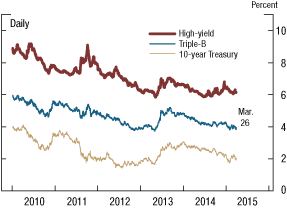
Source: Staff estimates of smoothed corporate yield curves based on data from BofA Merrill Lynch Global Research, used with permission, and smoothed Treasury yield curve.
Some of this widening in spreads reflected increased concerns about the ability of firms in the energy sector to repay their borrowing in light of the sharp decline in the price of oil over the second half of the year. Despite the widening in spreads over Treasury securities, valuation pressures appeared notable in riskier corporate debt markets. Issuance of high-yield bonds remained high in 2014, as did issuance of leveraged loans (figure 2)--although the pace of issuance slowed late in the year.
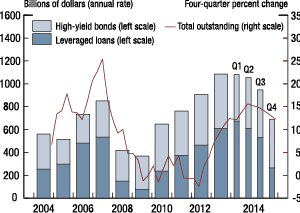
Note: Total outstanding is quarterly data. Data include bonds and loans to both financial and nonfinancial companies, as well as unrated bonds and loans.
Source: Standard & Poor's Leveraged Commentary & Data (LCD); Mergent Corporate Fixed Income (FISD). S&P and its third-party information providers expressly disclaim the accuracy and completeness of the information provided to the Board, as well as any errors or omissions arising from the use of such information. Further, the information provided herein does not constitute, and should not be used as, advice regarding the suitability of securities for investment purposes or any other type of investment advice.
As a result, the level of such risky debt grew more than 10 percent in 2014, the third year of growth in excess of 10 percent. In addition, the underwriting quality of leveraged loans arranged or held by banking institutions remained relatively weak in 2014, although there may have been some improvement late in the year in response to supervisory enforcement of the 2013 guidance for leveraged lending. For example, debt multiples over earnings on new deals remain high relative to historical averages but decreased somewhat, on balance, in the fourth quarter of 2014. Even so, the increase in borrowing and loose standards for lending over recent years could imply that investors in high-yield bonds and leveraged loans are exposed to larger risks of low returns or losses in coming years, and the growth in debt among lower-rated corporations may place strains on these firms, especially if macroeconomic conditions turn out to be weaker than expected. Indeed, as described in more detail later, the 2015 round of Federal Reserve stress testing explored the potential strains on participating institutions that could stem from a large deterioration in the credit quality of risky corporate borrowers in its severely adverse scenario.
The commercial real estate market exhibited growing valuation pressures over the course of 2014. Prices have risen relative to rents, and lending standards have eased. There have also been indications of weakening in underwriting standards in securitizations, such as an increased share of interest-only loans and rising loan-to-value ratios in commercial mortgage-backed securities (CMBS) pools. However, unlike corporate debt more broadly, the volume of commercial real estate debt outstanding has begun to accelerate appreciably only over the past year.
In other markets, valuation pressures appear moderate. Broad measures of equity prices rose about 10 percent over the course of 2014, but the equity premium, measured as the gap between the expected return on equity and the real long-term Treasury yield, is estimated to have remained relatively wide. However, equity prices were high relative to aggregate sales, reflecting high profit margins. In addition, residential real estate valuations appear within historical norms. For example, house prices relative to rents--one measure of valuations--have remained well within a typical range and remain far below the levels seen in the past decade across much of the country (figure 3).
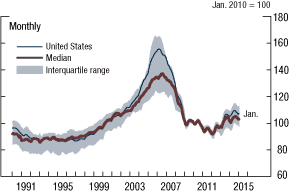
Note: Percentiles are based on 25 metropolitan statistical areas.
Source: For house prices, CoreLogic; for rent data, Bureau of Labor Statistics.
Leverage in the Financial System
The financial strength of the banking sector has continued to improve. Both the ratio of Tier 1 common equity to risk-weighted assets and the leverage ratio have risen to levels far above those seen in the mid-2000s (figure 4). The increase in capital reflects the tougher standards implemented globally as part of the Basel III process and additional efforts implemented following the passage of the Dodd-Frank Act, including more stringent standards and the annual stress tests for larger banking organizations. As a result of steady improvements in capital positions since the financial crisis, U.S. banks, in aggregate, appear to be better positioned to absorb potential shocks, such as those related to litigation, falling oil prices, and financial contagion stemming from abroad.
Securitization, which continues to be an important means of financing for several asset classes, remains relatively subdued, though issuance of non-agency CMBS and collateralized loan obligations (CLOs) continued to be robust amid continued reports of relatively accommodative underwriting standards for the underlying assets. Recent results from the Federal Reserve's Senior Credit Officer Opinion Survey on Dealer Financing Terms indicate that the use of financial leverage by institutional investor clients to fund the purchases of securities was little changed over recent quarters, although demand for funding non-agency residential mortgage-backed securities and high-yield bonds has been rising recently.1
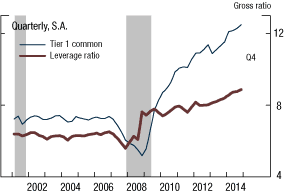
Note: The shaded bars indicate periods of business recession as defined by the National Bureau of Economic Research. CCAR is Comprehensive Capital Analysis and Review.
Source: Federal Reserve Board, FR Y-9C, Consolidated Financial Statements for Bank Holding Companies.
Liquidity Risks and Maturity Transformation by the Financial System
Bank balance sheets show continued improvement in liquidity positioning as the largest BHCs transition to Basel III liquidity requirements. The Basel III liquidity coverage ratio (LCR) requirement began phasing in for U.S. BHCs with greater than $250 billion in consolidated assets on January 1, 2015, and will take full effect in January 2017. In January 2016, a "modified" LCR requirement for BHCs with between $50 billion and $250 billion in assets will begin to be phased in.
Against this backdrop, balance sheet data through 2014:Q4 show the ratio of high-quality liquid assets to total assets at large- and medium-sized BHCs continued to grow (figure 5).
Short-term wholesale funding remained subdued throughout 2014. Net overnight borrowing at broker-dealers against fixed-income securities continued to trend down (figure 6).
The total outstanding dollar values of commercial paper and money market mutual funds (MMFs) were relatively unchanged in 2014. Structural vulnerabilities at MMFs persist: In particular, prime MMFs are vulnerable to investor runs if a drop in the credit quality of their assets or a decline in the willingness of market participants to bear credit risk induces a fall in the market value of their assets. The U.S. Securities and Exchange Commission (SEC) rules that will require institutional prime MMFs to move from a fixed to a floating net asset value starting in 2016 may mitigate their susceptibility to runs. The SEC will monitor the effects of the new rules after they are implemented.
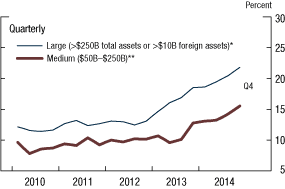
* Bank holding companies (BHCs) subject to the full liquidity coverage ratio (LCR) rule.
** BHCs subject to modified LCR rule.
Source: High-quality liquid assets estimated using quarter-end balances reported in filings of Federal Reserve Board reporting forms FR Y-9C (Consolidated Financial Statements for Bank Holding Companies) and FR 2900 (Report of Transaction Accounts, Other Deposits, and Vault Cash).
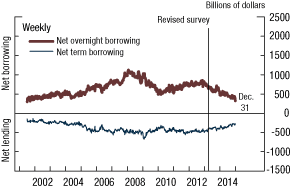
Note: Term financing refers to agreements with an original fixed maturity of more than one business day. Overnight financing refers to agreements with an original fixed maturity of one business day and agreements with no specific maturity that can be terminated on demand by either the borrower or lender. Net borrowing is the difference between funds received (borrowing) and funds paid (lending).
Source: Federal Reserve Board, FR 2004C, Weekly Report of Dealer Financing and Fails.
There are signs that the structure of some asset markets is changing due to changes in broker-dealer activities and increased trading speeds that are contributing to a buildup of liquidity risks in some markets. In addition, the growth of bond mutual funds and exchange-traded funds (ETFs) in recent years means that these funds now hold a much higher fraction of the available stock of relatively less liquid assets--such as high-yield corporate debt, bank loans, and international debt--than they did before the financial crisis. It is possible that, because mutual funds and ETFs may appear to offer greater liquidity than the markets in which they transact, their growth heightens the potential for a forced sale in the underlying markets if some event were to trigger large volumes of redemptions. This possibility--among other potential vulnerabilities--was the subject of a recent request for comments from the public issued by the FSOC (see "Financial Stability Oversight Council Activities" later in this section).
Borrowing by the Nonfinancial Sector
Excessive borrowing by the private nonfinancial sector has been an important contributor to financial crises. Highly indebted households and nonfinancial businesses may have a difficult time withstanding negative shocks to incomes or asset values and may be forced to curtail spending in ways that amplify the effects of financial shocks. In turn, losses among households and businesses can lead to mounting losses at financial institutions, creating an "adverse feedback loop" in which weakness among households, nonfinancial businesses, and financial institutions causes further declines in income and financial losses, potentially leading to financial instability and a sharp contraction in economic activity.
Borrowing by households remained relatively subdued through the fourth quarter of 2014. At the same time, borrowing by the nonfinancial business sector has grown only moderately. As a result, the ratio of household and nonfinancial business credit to nominal GDP has remained significantly below the peak seen in the 2000s (figure 7). Nonetheless, this ratio remains above levels seen prior to the mid-2000s.
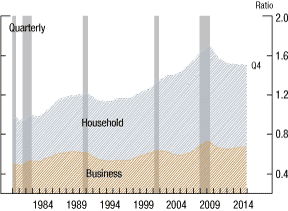
Note: The shaded bars indicate periods of business recession as defined by the National Bureau of Economic Research.
Source: Federal Reserve Board, Statistical Release Z.1, "Financial Accounts of the United States."
Within the household sector, the level of borrowing has edged up among households with strong credit histories, while borrowing by households with damaged credit histories--so-called subprime borrowing--contracted further, in the aggregate, in 2014. The combination of anemic growth in borrowing in the aggregate and the tendency for such growth to represent borrowing by households with strong credit histories suggests that vulnerabilities from household borrowing did not rise in 2014. Nonetheless, pockets of household credit markets witnessed a shift toward borrowing in riskier credit segments--for example, in subprime auto lending--a trend that should be monitored.
In the business sector, the rapid growth in borrowing in riskier segments of corporate debt markets, highlighted in the discussion of asset valuations earlier, has led to a notable increase in leverage--that is, debt relative to book equity--among speculative-grade corporations (figure 8).
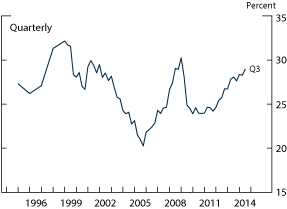
Note: Data are annual until 1999 and quarterly thereafter. Net leverage is the ratio of the book value of total debt minus cash and cash equivalents to the book value of total assets.
Source: S&P Capital IQ Compustat© 2015 Standard & Poor's Financial Services LLC ("S&P"). All rights reserved. For intended recipient only. No further distribution and/or reproduction permitted.
Macroprudential Supervision of Large, Complex Financial Institutions
In this Section:
Large, complex financial institutions interact with financial markets and the broader economy in a manner that may--during times of stress and in the absence of an appropriate regulatory framework and effective supervision--lead to financial instability.2
Key Supervisory Activities
One important element of enhanced supervision of large banking organizations is the stress-testing process, which includes the Dodd-Frank Act stress tests and the Comprehensive Capital Analysis and Review. In addition to fostering the safety and soundness of the participating institutions, stress tests embed macroprudential elements by
- examining the loss-absorbing capacity of institutions under a common macroeconomic scenario that has features similar to the strains experienced in a severe recession and which includes, as appropriate, identified salient risks;
- conducting horizontal testing across large institutions to understand the potential correlated exposures; and
- considering the effects of counterparty distress on the largest, most interconnected firms.
The macroeconomic and financial scenarios that are used in the stress tests have proved to be an important macroprudential tool. As described in the 2013 policy statement on developing scenarios for stress tests, the Federal Reserve adjusts the severity of the macroeconomic scenario in a way that counteracts the natural tendency for risks to build within the financial system during periods of strong economic activity.3 The scenarios can also be used to assess the financial system's vulnerability to particularly significant risks and to highlight certain risks to institutions participating in the testing.4 In a severely adverse scenario for 2015 (released in October 2014), the U.S. corporate sector experiences increases in financial distress that are even larger than would be expected in a severe recession.5 This deterioration in credit quality is particularly concentrated in riskier firms. Investors pull back from a variety of assets linked to risky corporate borrowers and, in particular, highly leveraged corporations. Spreads on assets linked to these corporations, particularly high-yield bonds, leveraged loans, and CLOs backed by leveraged loans, widen to the same levels as the peaks reached in the 2007-09 recession. These developments were motivated, in part, by the rapid growth in debt owed by risky firms and valuation pressures observed in related markets that were highlighted earlier in this section.
The Federal Reserve incorporates a macroprudential approach, too, in its supervision of FMUs. In 2014, the Federal Reserve Board updated its risk-management expectations for FMUs. For designated FMUs for which the Board or another federal banking agency serves as the supervisory agency under title VIII of the Dodd-Frank Act, the Board amended its risk-management standards to take into account new international standards for such entities (effective December 2014).
As with other elements of supervision, a more thorough review of activities in 2014 is discussed in section 4, "Supervision and Regulation."
Key Regulatory Activities
Over the course of 2014, the Federal Reserve has taken a number of steps to continue improving the resiliency of the financial system, including approval of a final rule establishing enhanced prudential standards with respect to capital, liquidity, and risk management for large U.S. BHCs and FBOs (pursuant to section 165 of the Dodd-Frank Act).
The enhanced prudential standards, together with stress testing and other regulatory safeguards, help ensure that large U.S. BHCs and FBOs operating in the United States have robust levels of capital and liquidity and strong risk management. Together, these efforts not only help ensure that these firms are financially robust individually, but also limit the risk that financial distress at these firms could cause negative spillovers to the financial sector and the broader economy. They are complemented by new rules and proposals concerning liquidity coverage ratios and strengthened capital requirements for global systemically important financial institutions, including proposed higher capital requirements for institutions more reliant on wholesale short-term funding. For more information on enhanced prudential standards activity, see section 4, "Supervision and Regulation."
During the 2007-09 financial crisis, the lack of effective resolution strategies contributed to the pernicious spillovers of distress at or between individual institutions and from those institutions to the broader economy. The Federal Reserve, in collaboration with other U.S. agencies, has continued to work with large financial institutions to develop a range of recovery and resolution strategies in the event of their distress or failure. Improvements in resolution planning will mitigate adverse effects from perceptions of "too big to fail" and contribute to more orderly conditions in the financial system if institutions face strains. For more information on recovery and resolution planning activity, see section 4, "Supervision and Regulation."
Domestic and International Cooperation and Coordination
In this Section:
The Federal Reserve cooperated or coordinated with both domestic and international institutions in 2014 to promote financial stability.
Financial Stability Oversight Council Activities
As mandated by the Dodd-Frank Act, the FSOC was created in 2010 and is chaired by the Treasury Secretary (box 3). It establishes an institutional framework for identifying and responding to sources of systemic risk. The Federal Reserve Chairman, along with other financial regulators, is a member of the FSOC.
Through collaborative participation in the FSOC, U.S. financial regulators monitor not only institutions, but the financial system as a whole. The Federal Reserve plays an important role in this macroprudential framework: It assists in monitoring financial risks, analyzes the implications of those risks for financial stability, and identifies steps that can be taken to mitigate those risks. In addition, when an institution is designated by the FSOC as systemically important, the Federal Reserve assumes responsibility for supervising that institution.
In 2014, the Federal Reserve worked, in conjunction with other FSOC participants, on several major initiatives:
- Conference examining asset management industry. On May 19, 2014, the FSOC held a conference examining the asset management industry and its relationship to financial stability. Participants included staff from U.S. government agencies, the private sector (including individuals from the asset management industry), and academic participants, among others.
- Roundtable on designation process. On November 12, 2014, the FSOC hosted a roundtable to discuss possible improvements to the process for designating systemically important financial institutions.
- Request for public comments on asset management industry risks. On December 18, 2014, as part of its ongoing analysis of potential risks to the financial system posed by the asset management industry, the FSOC released a notice seeking public comment about potential risks to the system associated with certain products and activities in the asset management industry relating to liquidity and redemptions, leverage, operational functions, and resolution.
- Determination of an additional systemically important entity. On December 19, 2014, the FSOC announced its final determination to designate MetLife as a systemically important nonbank financial company. The determination was based on the FSOC's assessment that material financial distress at MetLife could pose a threat to the financial stability of the United States.6
Box 3. Regular Reporting on Financial Stability Oversight Council Activities
The Financial Stability Oversight Council (FSOC), created under the Dodd-Frank Wall Street Reform and Consumer Protection Act of 2010 and chaired by the Secretary of the Treasury Department, meets regularly to coordinate on financial stability topics that potentially affect the U.S. economy and discloses its activities.
- Monthly meeting minutes. In 2014, the FSOC met monthly, and the minutes for each meeting are available on the U.S Treasury website (www.treasury.gov/initiatives/fsoc/council-meetings/Pages/meeting-minutes.aspx).
- FSOC annual report. On May 7, 2014, the FSOC released its fourth annual report (www.treasury.gov/initiatives/fsoc/studies-reports/Pages/2014-Annual-Report.aspx), which includes a review of key developments through the beginning of 2014 and a set of recommended actions that could be taken to ensure financial stability and to mitigate systemic risks that affect the economy.
For more on the FSOC, see www.treasury.gov/initiatives/fsoc/pages/home.aspx.
Return to textFinancial Stability Board Activities
The Federal Reserve participates in international bodies, such as the FSB, given the interconnected global financial system and the global activities of large U.S. financial institutions.
The FSB is an international body that monitors the global financial system and promotes the adoption of sound policies across countries, with much activity in recent years focused on financial stability. The Federal Reserve participates in the FSB, along with the SEC and the U.S. Treasury.7
In 2014, the Federal Reserve continued its active participation in the FSB. The FSB is engaged in several issues, including shadow banking, supervision of global systemically important financial institutions, and the development of effective resolution regimes for large financial institutions.
References
1. The Senior Credit Officer Opinion Survey on Dealer Financing Terms is available on the Board's website at www.federalreserve.gov/econresdata/releases/scoos.htm. Return to text
2. For more on the Federal Reserve's supervision and regulation of large institutions, and especially related to the integration of the microprudential objective of safety and soundness of individual institutions with the macroprudential efforts outlined later in this section, see section 4, "Supervision and Regulation. Return to text
3. See Board of Governors of the Federal Reserve System (2013), "Federal Reserve Board Issues Final Policy Statement for Developing Scenarios for Future Capital Planning and Stress Testing Exercises," press release, November 7, www.federalreserve.gov/newsevents/press/bcreg/20131107a.htm. Return to text
4. In 2014, 30 institutions participated in these stress tests. For more information, see "Stress Tests and Capital Planning" on the Federal Reserve Board's website at www.federalreserve.gov/bankinforeg/stress-tests-capital-planning.htm. Return to text
5. See Board of Governors of the Federal Reserve System (2014), 2015 Supervisory Scenarios for Annual Stress Tests Required under the Dodd-Frank Act Stress Testing Rules and the Capital Plan Rule (Washington: Board of Governors, October), www.federalreserve.gov/newsevents/press/bcreg/bcreg20141023a1.pdf. Return to text
6. For more information, see U.S. Department of the Treasury (2014), "Financial Stability Oversight Council Announces Nonbank Financial Company Designation," press release, December 19, www.treasury.gov/press-center/press-releases/Pages/jl9726.aspx. Return to text
7. See the Financial Stability Board website at www.financialstabilityboard.org ![]() . Return to text
. Return to text
